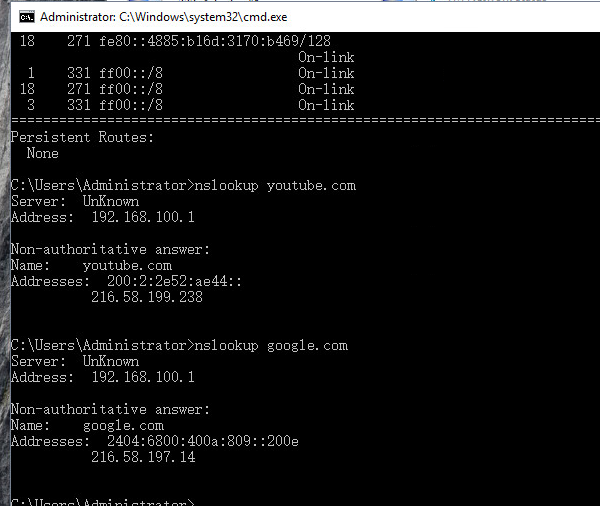跨长城有很多种方法,这里还是使用比较常用的 Shadowsocks 配合上一篇中使用 CentOS 搭建的软路由来实现透明翻墙。
PS:由于发现访问国外网站速度平均不如使用代理后访问的速度,于是直接使用了暴力的 GeoIP 指定非 CN IP 直接通过本地代理访问。
本篇需用到的组件(解决 DNS 污染问题以及提供代理通道):
上篇中配置 CentOS 中所包含的 Dnsmasq, iptables 等组件
pdnsd : 提供 TCP查询 获得可靠清洁的 DNS 记录。这个工具很久没有维护了,然而在 TCP 查询 DNS 时候,自己测试结果要快于 unbound 之类。当然使用 ss-tunnel 来转发 DNS 亦可,只是这边环境对 UDP 不友好,就没采用
ChinaDNS : 清洗被污染的 DNS 记录
dnsmasq-china-list : 国内域名列表,指定国内域名直接通过国内 DNS 进行解析,缓解 CDN 问题
Shadowsocks-libev : 包含多个组件,我们用 ss-redir 来实现重定向
安装配置 pdnsd 于其官方页面获得 x86_64平台的下载地址 使用 curl 下载 1 curl -O http://members.home.nl/p.a.rombouts/pdnsd/releases/pdnsd-1.2.9a-par_sl6.x86_64.rpm
yum 本地安装 1 yum localinstall pdnsd-1.2.9a-par_sl6.x86_64.rpm
编辑其配置文件 参考配置 1 2 3 4 5 6 7 8 9 10 11 12 13 14 15 16 17 18 19 20 21 22 23 24 25 26 27 28 29 30 31 32 33 34 35 36 37 38 39 40 41 42 global { perm_cache=0; #关闭 pdnsd 的缓存 cache_dir="/var/cache/pdnsd"; run_as="pdnsd"; server_ip = 127.0.0.1; #监听本地 server_port = 53535; #监听本地 53535 端口,注意错开 Dnsmasq, ChinaDNS 的端口 status_ctl = on; query_method=tcp_only; #修改为仅通过 TCP 查询 min_ttl=15m; # Retain cached entries at least 15 minutes. max_ttl=1w; # One week. timeout=10; # Global timeout option (10 seconds). neg_domain_pol=on; udpbufsize=1024; # Upper limit on the size of UDP messages. } server { label= "opendns"; ip = 208.67.220.220, 208.67.222.222; #上级 DNS 地址,需为国外支持 TCP 查询且无污染投毒的 DNS reject = 208.69.32.0/24, # You may need to add additional address ranges 208.69.34.0/24, # here if the addresses of their search engines 208.67.219.0/24, # change. 208.67.217.0/24, 208.67.216.0/24; reject_policy = fail; port = 443; #上级 DNS 端口,这里使用 tcp 查询配合 443 端口 timeout=4; #查询超时 uptest=ping; interval=10m; purge_cache=off; edns_query=yes; } server { label= "v2ex"; ip = 199.91.73.222; #V2EX 只有這個地址有非標準端口所以單獨放出來 port = 3389; #指定支持的非標準端口 timeout=4; uptest=ping; ping_timeout = 100; interval=10m; purge_cache=off; edns_query=off; }
启动&开机自启 1 2 systemctl start pdnsd systemctl enable pdnsd
验证 pdnsd 正常工作(可查询且无投毒) 1 dig @127.0.0.1 google.com -p53535
安装配置 ChinaDNS
本示例中 ChinaDNS 路径: /usr/local/other/chinadns-1.3.2
参照其官方 Github 中 Linux/Unix 的安装方法
下载源码到本地,编译 1 2 mkdir -p /usr/local /other/chinadns-1.3.2 && cd /usr/local /other/chinadns-1.3.2 ./configure && make
替换 IP 黑名单 其自带一个 IP 黑名单(iplist.txt),以及一个 中国区 IP 列表 (chnroute.txt ),我们这里将其 chnroute 替换为 ipdeny 提供的最新 list
1 curl http://www.ipdeny.com/ipblocks/data/aggregated/cn-aggregated.zone > ipdeny-cn.txt
尝试启动 ChinaDNS 本示例监听了 5353 端口,加载黑名单,国内IP名单,开启压缩指针,并指定 180.76.76.76 (百度 DNS)为国内 DNS,127.0.0.1:53535 (之前配置的pdnsd)为国外 DNS,并且开启 verbose 调试,运行于后台
1 /usr/local /bin/chinadns -l /usr/local /other/chinadns-1.3.2/iplist.txt -p 5353 -c /usr/local /other/chinadns-1.3.2/ipdeny-cn.txt -s 180.76.76.76,127.0.0.1:53535 -d -m -v &
验证其正常工作(正常返回 pass 结果) 1 dig @127.0.0.1 google.com -p5353
结束调试并添加至开机自启 1 2 killall chinadns echo "nohup /usr/local/bin/chinadns -l /usr/local/other/chinadns-1.3.2/iplist.txt -b 127.0.0.1 -p 5353 -c /usr/local/other/chinadns-1.3.2/ipdeny-cn.txt -s 180.76.76.76,127.0.0.1:53535 -d -m -v > /var/log/user/chinadns 2>&1 &" >> /etc/rc.local
记得如果时第一次启用 rc.local 先
配置 Dnsmasq 添加 dnsmasq-china-list 加速国内解析,并解决部分 CDN 问题 1 2 curl https://raw.githubusercontent.com/felixonmars/dnsmasq-china-list/master/accelerated-domains.china.conf > /etc/dnsmasq.d/accelerated-domains.china.conf curl https://raw.githubusercontent.com/felixonmars/dnsmasq-china-list/master/bogus-nxdomain.china.conf > /etc/dnsmasq.d/bogus-nxdomain.china.conf
重新加载 Dnsmasq
会自动载入 /etc/dnsmasq.d 目录的配置文件
测试 Dnsmasq 1 dig @127.0.0.1 google.com
安装配置 Shadowsocks-libev 参考其官方 Github 得知,RHEL/CentOS 安装可通过源 实现 1 2 3 4 curl https://copr.fedorainfracloud.org/coprs/librehat/shadowsocks/repo/epel-7/librehat-shadowsocks-epel-7.repo > /etc/yum.repos.d/librehat-shadowsocks-epel-7.repo yum update yum install shadowsocks-libev
使用 ss-redir 监听本地端口 1 nohup /usr/bin/ss-redir -s {SS服务器地址} -p {SS服务器端口} -l {本地监听端口} -k {SS密钥} -m aes-256-cfb -b 0.0.0.0 -v > /var/log /user/ss-redir 2>&1 &
添加至开机自启 1 echo "nohup /usr/bin/ss-redir -s {SS服务器地址} -p {SS服务器端口} -l {本地监听端口} -k {SS密钥} -m {SS加密方式} -b 0.0.0.0 -v > /var/log/user/ss-redir 2>&1 &" > /etc/rc.local
安装 xtables-addons(GeoIP 模块) 先直接使用 yum 安装必要组件 1 2 3 yum install xtables-addons yum install kernel-devel-`uname -r` iptables-devel kernel-headers-`uname -r` yum install gcc gcc-c++ make automake unzip zip perl perl-Text-CSV_XS xz
下载 addons 源码包并解压 1 2 3 curl -O http://downloads.sourceforge.net/project/xtables-addons/Xtables-addons/xtables-addons-2.10.tar.xz tar -xvf xtables-addons-2.10.tar.xz cd xtables-addons-2.10
由于 CentOS-xtables 兼容性问题,修改编译设置,注释以下两行
编译 1 2 ./configure make && make install
完成后,进入源码包下 geoip 目录,下载地理 IP 包 1 2 3 cd geoip./xt_geoip_dl ./xt_geoip_build *.csv
完成后复制 BE LE 两个目录至指定路径,GeoIP 模块配置完成 1 2 mkdir -p /usr/share/xt_geoip/ cp -r {BE,LE} /usr/share/xt_geoip/
配置 iptables,实现流量转发 配置示例
若应用 geoip 行时出现找不到 chain 错误,说明 geoip 模块安装不正确
1 2 3 4 5 6 7 8 9 10 11 12 iptables -t nat -N SHADOWSOCKS iptables -t nat -A SHADOWSOCKS -d {SS服务器IP地址}/32 -j RETURN iptables -t nat -A SHADOWSOCKS -d 0.0.0.0/8 -j RETURN iptables -t nat -A SHADOWSOCKS -d 10.0.0.0/8 -p tcp -j RETURN iptables -t nat -A SHADOWSOCKS -d 127.0.0.1/8 -p tcp -j RETURN iptables -t nat -A SHADOWSOCKS -d 169.254.0.0/16 -p tcp -j RETURN iptables -t nat -A SHADOWSOCKS -d 172.16.0.0/12 -p tcp -j RETURN iptables -t nat -A SHADOWSOCKS -d 192.168.0.0/16 -p tcp -j RETURN iptables -t nat -A SHADOWSOCKS -d 224.0.0.0/4 -j RETURN iptables -t nat -A SHADOWSOCKS -d 240.0.0.0/4 -j RETURN iptables -t nat -A SHADOWSOCKS -p tcp -m geoip ! --dst-cc CN -j REDIRECT --to-ports 1080 iptables -t nat -A PREROUTING -p tcp -j SHADOWSOCKS
尝试访问墙外网站,成功则 IP 显示为 SS 的出口 IP
保存 iptables 规则 1 iptables-save > /etc/sysconfig/iptables
Done!







